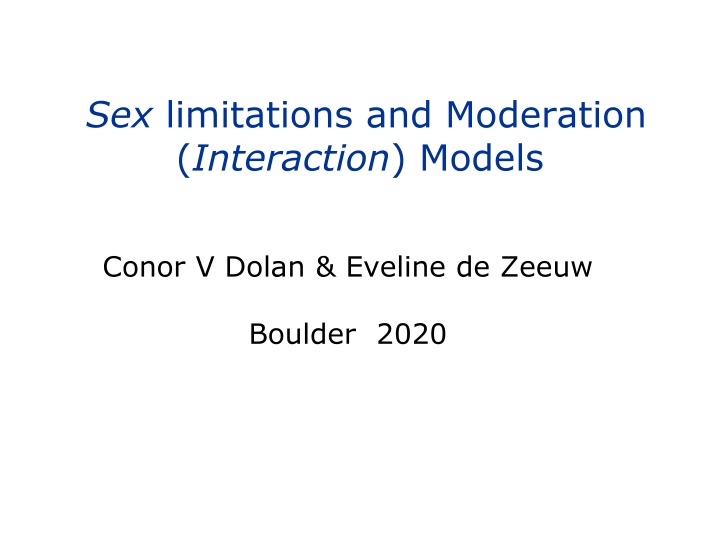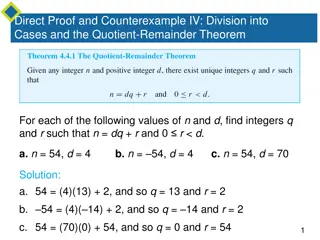
Moderation Effects in Interaction Models
Explore the significance of moderation effects in interaction models, how they impact statistical tests, and the importance of including sources of heterogeneity as moderators to ensure unbiased estimates. Learn about the diathesis-stress model and how it identifies childhood trauma as a moderator of genetic effects on depression.
Download Presentation

Please find below an Image/Link to download the presentation.
The content on the website is provided AS IS for your information and personal use only. It may not be sold, licensed, or shared on other websites without obtaining consent from the author. If you encounter any issues during the download, it is possible that the publisher has removed the file from their server.
You are allowed to download the files provided on this website for personal or commercial use, subject to the condition that they are used lawfully. All files are the property of their respective owners.
The content on the website is provided AS IS for your information and personal use only. It may not be sold, licensed, or shared on other websites without obtaining consent from the author.
E N D
Presentation Transcript
Sex limitations and Moderation (Interaction) Models Conor V Dolan & Eveline de Zeeuw Boulder 2020
Phi = Ai+ Ei Standard AE model 2A or .5 2A A E A E 2E 2A 2A 2E 1 1 1 1 pheno Twin 1 pheno Twin 2 1 mean(Ph) = var(Ph) = 2Ph = 1* 2A*1+ 1* 2E*1 = 2A+ 2E
Phi = a*Ai+ e*Ei 1 or .5 A E A E 1 1 1 1 a e a e pheno Twin 1 pheno Twin 2 1 mean(Ph) = var(Ph) = 2Ph = VPh = a*1*a + e*1*e= a2 + e2
Heres the ACE model (variance component): MZ = 2A + 2C + 2E 2A + 2C 2A + 2C 2A + 2C + 2E MZ = DZ = 2A + 2C + 2E 2A + 2C 2A + 2C 2A + 2C + 2E DZ = NOTE: When we fit this model we assume that the model holds in the population of interest. - conceptually and statistically a big deal.
What if the population comprises two discernable (sub)populations of interest, e.g., males and females? Main effect of sex on phenotype Sex by A (genotype), E (environment) interactions If we ignore the source of heterogeneity the estimates of , 2E, 2A may be biased ... and even the statistical tests may be affected .... BAD!
What to do? Include source of heterogeneity, moderator, in the model (sex, age, .... ANY VARIABLE THEORY prescribes) to render testable the moderation effects. E.g., diathesis-stress model identifies childhood trauma as a moderator of genetic effects on depression. Colodro-Conde L, et al. A direct test of the diathesis-stress model for depression. Mol. Psychiatry. 2018;23:1590 1596. doi: 10.1038/mp.2017.130.
What is moderation (a.k.a. interaction)? To test it (using statistics), and we define it statistically.
no moderation ... homoskedatic....homogeneity Environmental Dispersion Phenotypic scores Variance of E given A score is approximately constant Genetic level (score on A) Phi = a*Ai+ e*Ei Homoskedastic model: e is constant over levels of A: environmental effects are the same given any A
Environmental Dispersion 6 4 Variance of E given A score isnot constant Phenotypic scores 2 y 0 -2 -4 -4 -3 -2 -1 0 1 2 3 x Genetic level (score on A) A x E as genetic control of sensitivity to different environments: heteroskedasticity (heterogeneity) e=fe(A) or 2E =ge(A) -> Environmental effects (E) systematically vary with A. A moderator ...
6 Conditional variance of A given E isnot constant 4 Phenotypic scores 2 y 0 -2 -4 -4 -3 -2 -1 0 1 2 3 x Environmental level (score on E) A x E as environmental control of genetic effects: heteroskedasticity (a=fa(E) or 2A =ga(E)). E moderator
Genetic variance or (and) Environmental (C and / or E) variance given M 6 4 Phenotypic scores 2 y 0 -2 -4 -4 -3 -2 Moderator level -1 0 1 2 3 x (score on the measured moderator) Moderation of effects (A,C,E) by measured moderator M: heteroskedasticity a=fa(M), c=fc(M), e=fe(M) or 2A =ga(M), 2C =gc(M), 2E =ge(M) M moderaties the effects of A, C (or D) and E
Moderators are measured variables may be binary A effects moderated by marital status (M): Unmarried women show greater levels of genetic influence on depression (Heath et al., 1998). A effects moderated by religious upbringing (M): religious upbringing diminishes A effects on the personality trait of disinhibition (Boomsma et al., 1999). Sex (as a binary moderator) discussed below .
Moderators are measured variables may be continuous Age as a moderator of A, C, E variance components (Age x A,C,E interaction)
Intelligence (western / us populations) 0.7 Genes (A) Shared Environment (C) Nonshared Environment (E) 0.6 0.5 0.4 Variance 0.3 0.2 0.1 0.0 2 4 6 8 10 12 14 16 18 Age (Years) Tucker-Drob & Bates (2015)
ACE model (A,C,E standardized) continuous phenotype 1 or .5 1 A C E A C E c c a e a e pheno Twin 1 pheno Twin 2 1
ACE model + Main effect on Means A C E A C E c c a e a e m+ MM2 m+ M M1 Pheno Twin 1 Pheno Twin 2 1
m pheno Twin 1 1 m+ M M1 pheno Twin 1 1 M M1 equivalent Two representations of the regression of Phenotype on M ... Phenoi = m+ M M1i + residuali
Summary stats (no moderator) Means vector Covariance matrix (r = 1 or ) + + 2 2 2 a c e + + + 2 2 2 2 2 * r a c a c e
Allowing for a main effect of the moderator M Means vector (conditional on M) ( M m 1 M + ) + m M 2 i M i Covariance matrix (r = 1 or r= ) + + 2 2 2 a c e + + + 2 2 2 2 2 * r a c a c e
ACE model + main effect and effect on A path 1 A C E A C E c c e a+ XM1 a+ XM2 e m+ M M2 m+ M M1 Twin 1 Twin 1 Twin 2 Twin 2 1 M has main effect + moderation of A effect (a + xM1)
A C E 1 c e a+ XM1 m+ M M1 Twin 1 Twin 1 1 If M is binary (0/1) (instead of continuous) M1=0 mean= m & s2A= a2 M1=1 mean= m+ M& s2A= (a+ XM1)2 Test of moderation: test of X
A C E s2A 1 1 1+ XM1 m+ M M1 Twin 1 Twin 1 1 If M is binary (0/1) (instead of continuous) M1=0 mean= m & s2A= s2A M1=1 mean= m+ M& s2A= s2A(1+ X)2 Test of moderation: test of X
1 A C E A C E c + yM1 c + yM1 a+ XM1 a+ XM2 e + zM1 e + zM1 m+ M M2 m+ M M1 Twin 1 Twin 1 Twin 2 Twin 2 1 Main Effect on phenotype (linear regression) Effect path parameters: Moderation effects (A x M, C x M, E x M interaction). Test of moderation: Tests of x, y, z(3 df omibus test)
s2C s2A s2E C A E 1+ yM1 1+ XM1 1+ zM1 m+ M M1 Twin 1 1 A variance component version (just the twin 1 member)
Conditional expected variances Standard Twin Model: s2Ph = a2 + c2 + e2 or s2A + s2C + s2E Moderation Model: Var(Ph|M) = (a + XM)2 + (c + YM)2 + (e + ZM)2 or s2A(1 + XM)2 + s2C(1 + YM)2 + s2E(1 + ZM)2 Ph|M mean the phenotype given a value on M or the phenotype conditional on M
Conditional expected MZ / DZ covariances Cov(Ph1,Ph2|M)MZ= (a+ XM)2 + (c+ YM)2 Cov(Ph1,Ph2|M)DZ= (a+ XM)2 + (c+ YM)2 Cov(Ph1,Ph2|M)MZ= s2A(1+ XM)2 + s2C(1+ YM)2 Cov(Ph1,Ph2|M)DZ= s2A(1+ XM)2+s2C(1+ YM)2
Var (P|M) = (a + XM)2 + (c + YM)2 + (e + ZM)2 hst2|M = (a + XM)2 / Var (P|M) cst2|M = (c + YM)2 / Var (P|M) est2|M = (e + ZM)2 / Var (P|M) (hst2|M + cst2|M + est2|M) = 1 Standardized conditional on value of M.. But hst2|M can vary with M while X= 0! same applies to cst2|M and est2|M
a,c moderated? nope! (umx plots) only e moderated (umx plots) moderator moderator R code in the slide notes
1 / .5 1 1 A C E A C E c + yM1 c + yM1 a+ XM1 a+ XM2 e + zM1 e + zM1 m+ M M2 m+ M M1 Twin 1 Twin 1 Twin 2 Twin 2 1 But what have we assumed concerning M? So far treated like a definition variable (and a fixed regressor).
The M is a measured variable A a+ xM 1 m twin c+ yM C M M e+ zM E M is environmental? Sociaal support? Employment status? Marital status? (No No and No). The weather (yes)
Eu Ec Cc Ac Cu Au eu cm am cu em au M1 T1
rE rC rA Eu Ec Cc Ac Cu Au et cm am ct em at M1 T1 cov(M1,T1) = amrEat + cmrCct + emrEet var(T1) = at2 + ct2 + et2
Au Cu Cc Ac Ec Eu eu cu cm au em am M1 T1 cov(M1,T1) = amac + cmcc + emec var(T1) = ec2+ cc2+ ec2 + eu2+ cu2+ eu2
s2CM s2AT s2EM s2AM s2CT s2ET AT CT CM AM EM ET 1 1 1 1 1 1 M1 T1
Au Cu Cc Ac Ec Eu cm em am M1 T1 var(T1| M1) = (ec+ bec*M1)2 + (cc+ bcc*M1)2+ (ac+ bac*M1)2 + (eu+ beu*M1)2+ (cu+ bcu*M1)2+ (au+ bau*M1)2
MZ = DZ = 1 MZ=1 / DZ=.5 MZ = DZ = 1 MZ=1 / DZ=.5 Eu Eu Ac Ac Cc Cc Cu Cu Ec Ec Au Au eu+ beu*M2 eu+ beu*M1 cu+ bcu*M2 cu+ bcu*M1 au+ bau*M1 au+ bau*M2 cm cm em am am em M2 T2 M1 T1 umx function available!
Phenotype: externalizing behavior Moderators: academic achievement and engagement, antisocial and prosocial peer affiliations, mother-child and father-child relationship problems, and stressful life events. Arch Gen Psychiatry. 2009;66(6):640-648
What about non-linear moderation? E.g., extend the model from linear to linear + quadratic. ec+ bec1*M1 + bec2*M12 What about >1 moderators? Extend the model accordingly ec+ bec1*SES + bec2*AGE What about categorical data?
Sex special case.... DZOS! ... offer unique means to test hypotheses concerning genetic effects. 5 groups MZM, DZM, MZF, DZF, DZOS Considered in a 5 group model
2Am or .52Am Am Em Am Em 2Em 2Am 2Am 2Em 1 1 1 1 m m pheno Twin 1 pheno Twin 2 1 mean(Phm) = m var(Phm) = 2Ph = 2Am+ 2Em Males twins
2Af or .52Af Af Ef Af Ef 2Ef 2Af 2Af 2Ef 1 1 1 1 f f pheno Twin 1 pheno Twin 2 1 mean(Phf) = f var(Phf) = 2Ph = 2Af+ 2Ef Females twins
f = m? sex differences in main effects s2Af = s2Am? sex differences in A variance s2Ef = s2Em? sex differences in E variance (add s2Df = s2Dm or s2Cf = s2Cm )
AfAm or AfAm Af Ef Am Em 2Em 2Am 2Af 2Ef 1 1 1 1 m f pheno Twin f pheno Twin m 1 DZOS (f,m) twins
AfAm or rDZOS*AfAm Af Ef Am Em 2Em 2Am 2Af 2Ef 1 1 1 1 f m pheno Twin f pheno Twin m 1 DZOS twins rDZOS* Af Am note: rDZOS is not necessarily rDZOS = or rDZOS < ?
Models (ACE) (Stat or Subst) total homogeneity (Subst) f= m (main effect absent) 2Am= 2Af & rDZOS = 2Cm= 2Cf & 2Ef = 2Ef total variance homogeneity (Stat) f m (main effect present) 2Am= 2Af rDZOS = 2Cm= 2Cf & 2Ef = 2Ef
f m (main effect present) scalar sex limitation rDZOS = ( (Stat) 2Am 2Af & 2Cm 2Cf & 2Am= k* 2Af& 2Cm= k* 2Cf & 2Ef 2Ef 2Ef = k* 2Ef k is nonzero positive constant (to be estimated) raw variances differ, but standardized variances are equal 2Af /( 2Af+ 2Cf+ 2Ef) = k* 2Af /(k* 2Af+k* 2Cf+k* 2Ef) = k* 2Af / k*( 2Af+ 2Cf+ 2Ef) = 2Af /( 2Af+ 2Cf+ 2Ef) parsimonious model for sex differences in variance, but quite restrictive (and not Subst!)
f m (main effect present) non-scalar quantitative sex limitation rDZOS = (Subst) 2Am 2Af &/or 2Cm 2Cf &/or 2Am 2Af &genetic effects are different, but rDZOS = implies same genes in males and females. 2Ef 2Ef So: sex moderates genetic effects (e.g., gene expression).






















